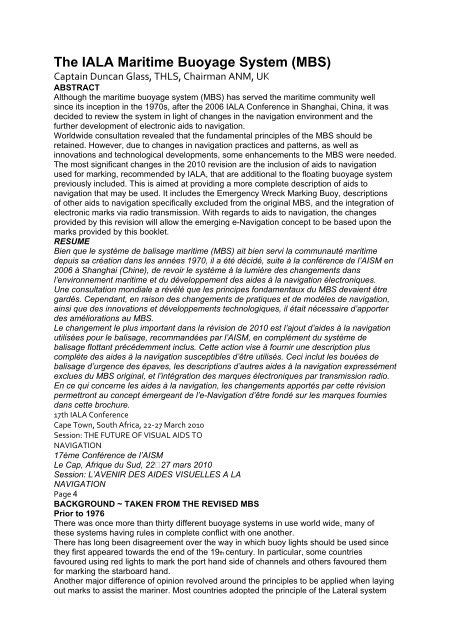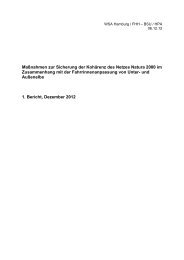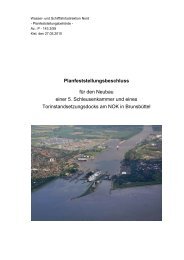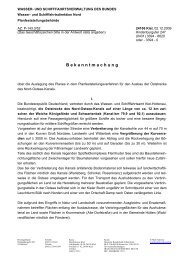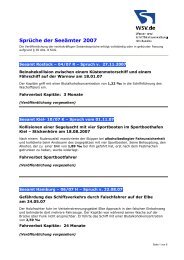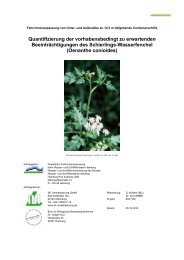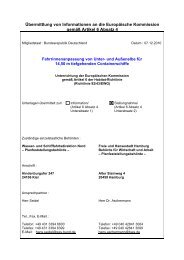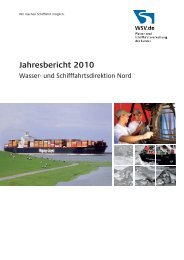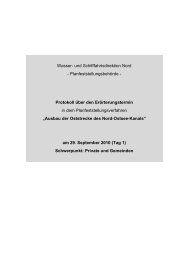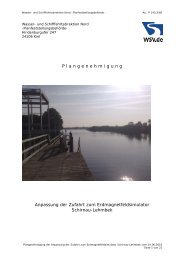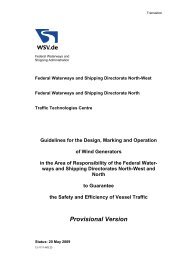The IALA Maritime Buoyage System (MBS)
The IALA Maritime Buoyage System (MBS)
The IALA Maritime Buoyage System (MBS)
Create successful ePaper yourself
Turn your PDF publications into a flip-book with our unique Google optimized e-Paper software.
<strong>The</strong> <strong>IALA</strong> <strong>Maritime</strong> <strong>Buoyage</strong> <strong>System</strong> (<strong>MBS</strong>)<br />
Captain Duncan Glass, THLS, Chairman ANM, UK<br />
ABSTRACT<br />
Although the maritime buoyage system (<strong>MBS</strong>) has served the maritime community well<br />
since its inception in the 1970s, after the 2006 <strong>IALA</strong> Conference in Shanghai, China, it was<br />
decided to review the system in light of changes in the navigation environment and the<br />
further development of electronic aids to navigation.<br />
Worldwide consultation revealed that the fundamental principles of the <strong>MBS</strong> should be<br />
retained. However, due to changes in navigation practices and patterns, as well as<br />
innovations and technological developments, some enhancements to the <strong>MBS</strong> were needed.<br />
<strong>The</strong> most significant changes in the 2010 revision are the inclusion of aids to navigation<br />
used for marking, recommended by <strong>IALA</strong>, that are additional to the floating buoyage system<br />
previously included. This is aimed at providing a more complete description of aids to<br />
navigation that may be used. It includes the Emergency Wreck Marking Buoy, descriptions<br />
of other aids to navigation specifically excluded from the original <strong>MBS</strong>, and the integration of<br />
electronic marks via radio transmission. With regards to aids to navigation, the changes<br />
provided by this revision will allow the emerging e-Navigation concept to be based upon the<br />
marks provided by this booklet.<br />
RESUME<br />
Bien que le système de balisage maritime (<strong>MBS</strong>) ait bien servi la communauté maritime<br />
depuis sa création dans les années 1970, il a été décidé, suite à la conférence de l’AISM en<br />
2006 à Shanghai (Chine), de revoir le système à la lumière des changements dans<br />
l’environnement maritime et du développement des aides à la navigation électroniques.<br />
Une consultation mondiale a révélé que les principes fondamentaux du <strong>MBS</strong> devaient être<br />
gardés. Cependant, en raison des changements de pratiques et de modèles de navigation,<br />
ainsi que des innovations et développements technologiques, il était nécessaire d’apporter<br />
des améliorations au <strong>MBS</strong>.<br />
Le changement le plus important dans la révision de 2010 est l’ajout d’aides à la navigation<br />
utilisées pour le balisage, recommandées par l’AISM, en complément du système de<br />
balisage flottant précédemment inclus. Cette action vise à fournir une description plus<br />
complète des aides à la navigation susceptibles d’être utilisés. Ceci inclut les bouées de<br />
balisage d’urgence des épaves, les descriptions d’autres aides à la navigation expressément<br />
exclues du <strong>MBS</strong> original, et l’intégration des marques électroniques par transmission radio.<br />
En ce qui concerne les aides à la navigation, les changements apportés par cette révision<br />
permettront au concept émergeant de l’e-Navigation d’être fondé sur les marques fournies<br />
dans cette brochure.<br />
17th <strong>IALA</strong> Conference<br />
Cape Town, South Africa, 22‐27 March 2010<br />
Session: THE FUTURE OF VISUAL AIDS TO<br />
NAVIGATION<br />
17ème Conférence de l’AISM<br />
Le Cap, Afrique du Sud, 22 27 mars 2010<br />
Session: L’AVENIR DES AIDES VISUELLES A LA<br />
NAVIGATION<br />
Page 4<br />
BACKGROUND ~ TAKEN FROM THE REVISED <strong>MBS</strong><br />
Prior to 1976<br />
<strong>The</strong>re was once more than thirty different buoyage systems in use world wide, many of<br />
these systems having rules in complete conflict with one another.<br />
<strong>The</strong>re has long been disagreement over the way in which buoy lights should be used since<br />
they first appeared towards the end of the 19th century. In particular, some countries<br />
favoured using red lights to mark the port hand side of channels and others favoured them<br />
for marking the starboard hand.<br />
Another major difference of opinion revolved around the principles to be applied when laying<br />
out marks to assist the mariner. Most countries adopted the principle of the Lateral system
whereby marks indicate the port and starboard sides of the route to be followed according to<br />
some agreed direction. However, several countries also favoured using the principle of<br />
Cardinal marks whereby dangers are marked by one or more buoys or beacons laid out in<br />
the quadrants of the compass to indicate where the danger lies in relation to the mark, this<br />
system being particularly useful in the open sea where the Lateral buoyage direction may<br />
not be apparent.<br />
<strong>The</strong> nearest approach to international agreement on a unified system of buoyage was<br />
reached at Geneva in 1936. This Agreement, drawn up under the auspices of the League of<br />
Nations, was never ratified due to the outbreak of World War II. <strong>The</strong> Agreement proposed<br />
the use of either Cardinal marks or Lateral marks but separated them into two different<br />
systems. It provided for the use of the colour red on port hand marks and largely reserved<br />
the colour green for wreck marking.<br />
At the end of World War II many countries found their aids to navigation destroyed and the<br />
process of restoration had to be undertaken urgently. In the absence of anything better, the<br />
Geneva rules were adopted with or without variation to suit local conditions and the<br />
equipment available. This led to wide and sometimes conflicting differences particularly in<br />
the crowded waters of North Western Europe.<br />
In 1957 the International Association of Lighthouse Authorities (<strong>IALA</strong>) was formed in order to<br />
support the goals of the technical lighthouse conferences which had been convening since<br />
1929.<br />
Attempts to bring complete unity had little success. Fresh impetus was given to the task of<br />
the <strong>IALA</strong> Technical Committee, by a series of disastrous wrecks in the Dover Strait area in<br />
1971. <strong>The</strong>se wrecks, situated in one lane of a traffic separation scheme, defied all attempts<br />
to mark them in a way that could be readily understood by mariners.<br />
<strong>The</strong>re were three basic issues to address:<br />
i. the need to retain existing equipment as far as possible to avoid undue expense<br />
ii. the need to define how the colours green and red were to be used when marking<br />
channels<br />
iii. the need to combine Lateral and Cardinal rules.<br />
To meet the conflicting requirements, it was thought necessary as a first step to formulate<br />
two systems, one using the colour red to mark the port hand side of the channels and the<br />
other using the colour red to mark the starboard hand side of channels. <strong>The</strong>se were called<br />
<strong>System</strong> A and <strong>System</strong> B, respectively.<br />
17th <strong>IALA</strong> Conference<br />
Cape Town, South Africa, 22‐27 March 2010<br />
Session: THE FUTURE OF VISUAL AIDS TO<br />
NAVIGATION<br />
17ème Conférence de l’AISM<br />
Le Cap, Afrique du Sud, 22 27 mars 2010<br />
Session: L’AVENIR DES AIDES VISUELLES A LA<br />
NAVIGATION<br />
Page 5<br />
<strong>The</strong> rules for <strong>System</strong> A, which included both cardinal and lateral marks, were completed in<br />
1976 and agreed by the International <strong>Maritime</strong> Organization (IMO). <strong>The</strong> <strong>System</strong> was<br />
introduced in 1977 and its use has gradually spread throughout Europe, Australia, New<br />
Zealand, Africa, the Gulf and some Asian Countries.<br />
From 1980<br />
<strong>The</strong> rules for <strong>System</strong> B were completed in early 1980. <strong>The</strong>se were considered to be suitable<br />
for application in North, Central and South America; Japan; Korea and <strong>The</strong> Philippines.<br />
<strong>The</strong> rules for the two <strong>System</strong>s were so similar that the <strong>IALA</strong> Executive Committee was able<br />
to combine the two sets of rules into one, known as “<strong>The</strong> <strong>IALA</strong> <strong>Maritime</strong> <strong>Buoyage</strong> <strong>System</strong>”<br />
(<strong>MBS</strong>). This single set of rules allows Lighthouse Authorities the choice of using red to port<br />
or red to starboard, on a regional basis; the two regions being known as Region A and<br />
Region B.<br />
At a Conference convened by <strong>IALA</strong> in November 1980 with the assistance of IMO and the<br />
International Hydrographic Organization (IHO), Lighthouse Authorities from 50 countries and
the representatives of nine International Organisations concerned with aids to navigation met<br />
and agreed to adopt the rules of the new combined <strong>System</strong>. <strong>The</strong> boundaries of the buoyage<br />
regions were also decided and illustrated on a map annexed to the rules. <strong>The</strong> Conference<br />
underlined the need for co-operation between neighbouring countries and with Hydrographic<br />
Services in the introduction of the new <strong>System</strong>.<br />
From 2010<br />
Although the maritime buoyage system (<strong>MBS</strong>) has served the maritime community well<br />
since its inception in the 1970s, after the 2006 <strong>IALA</strong> Conference in Shanghai, China, it was<br />
decided to review the system in light of changes in the navigation environment and the<br />
further development of electronic aids to navigation.<br />
Worldwide consultation revealed that the fundamental principles of the <strong>MBS</strong> should be<br />
retained. However, due to changes in navigation practices and patterns, as well as<br />
innovations and technological developments, some enhancements to the <strong>MBS</strong> were needed.<br />
Ideally, a unified marking arrangement would, in principle, be desirable for Regions A and B.<br />
All <strong>IALA</strong> Members view this change as impractical, detrimental to safety, and probably<br />
unachievable. However, with the aim of improving navigational safety, advances towards a<br />
global unified system can be achieved through adoption of common characteristics, such as<br />
consistent lighting rhythms, on port and starboard hand Marks regardless of region.<br />
<strong>The</strong> most significant changes in the 2010 revision are the inclusion of aids to navigation<br />
used for marking, recommended by <strong>IALA</strong>, that are additional to the floating buoyage system<br />
previously included. This is aimed at providing a more complete description of aids to<br />
navigation that may be used. It includes the Emergency Wreck Marking Buoy, descriptions<br />
of other aids to navigation specifically excluded from the original <strong>MBS</strong>, and the integration of<br />
electronic marks via radio transmission. With regards to aids to navigation, the changes<br />
provided by this revision will allow the emerging e-Navigation concept to be based upon the<br />
marks provided by this booklet.<br />
Thus, the <strong>IALA</strong> <strong>Maritime</strong> <strong>Buoyage</strong> <strong>System</strong> will continue to help all Mariners, navigating<br />
anywhere in the world, to fix their position and avoid dangers without fear of ambiguity, now<br />
and for the years to come.<br />
17th <strong>IALA</strong> Conference<br />
Cape Town, South Africa, 22‐27 March 2010<br />
Session: THE FUTURE OF VISUAL AIDS TO<br />
NAVIGATION<br />
17ème Conférence de l’AISM<br />
Le Cap, Afrique du Sud, 22 27 mars 2010<br />
Session: L’AVENIR DES AIDES VISUELLES A LA<br />
NAVIGATION<br />
Page 6<br />
GENERAL PRINCIPLES OF THE MARITIME BUOYAGE SYSTEMAND OTHER AIDS TO<br />
NAVIGATION<br />
<strong>The</strong> responsibility for safe navigation resides with the mariner, through the appropriate use<br />
of aids to navigation in conjunction with official nautical documents and prudent seamanship,<br />
including voyage planning as defined in IMO Resolutions.<br />
<strong>The</strong> <strong>IALA</strong> Aids to Navigation system comprises two components: <strong>The</strong> <strong>Maritime</strong> <strong>Buoyage</strong><br />
<strong>System</strong> and other aids to navigation. This is primarily a physical system, however all of the<br />
marks described in the revised booklet may be provided, presented and recorded by<br />
electronic means.<br />
Within this system there are six types of marks which may be used in combination. <strong>The</strong><br />
mariner can distinguish between these marks by identifiable characteristics. Lateral marks<br />
differ between <strong>Buoyage</strong> Regions A and B, as described below, whereas the other five types<br />
of marks are common to both regions.<br />
THE FIRST STEPS IN THE REVIEW<br />
<strong>The</strong> <strong>IALA</strong> Aids to Navigation Management (ANM) Committee agreed that the first step in the<br />
review of the <strong>Maritime</strong> <strong>Buoyage</strong> <strong>System</strong>, in accordance with the Council instructions to: “to<br />
review the system in light of changes in the shipping environment and the development of<br />
digital aids to navigation”, was to write to all <strong>IALA</strong> Members, under the Secretary General’s
signature, requesting their views on a review of the <strong>MBS</strong> and providing them with an<br />
accompanying rationale to assist them when considering their response<br />
<strong>The</strong> letter was worded as follows and produced a significant response from <strong>IALA</strong> Members.<br />
Dear <strong>IALA</strong> Member<br />
Re: <strong>IALA</strong> <strong>Maritime</strong> <strong>Buoyage</strong> <strong>System</strong><br />
I am writing to request your comments on and suggestions for improvements (if any)<br />
to the <strong>IALA</strong> <strong>Maritime</strong> <strong>Buoyage</strong> <strong>System</strong>.<br />
Please find attached to this letter, a brief rationale for reviewing the <strong>MBS</strong> and the<br />
preliminary findings made by the <strong>IALA</strong> Aids to Navigation Management (ANM)<br />
Committee.<br />
I will be grateful if you can respond to the <strong>IALA</strong> Secretariat by no later than 31<br />
December 2007.<br />
I look forward to hearing from you.<br />
<strong>The</strong> supporting rationale was as follows:<br />
Review of the <strong>IALA</strong> <strong>Maritime</strong> <strong>Buoyage</strong> <strong>System</strong> (<strong>MBS</strong>)<br />
Background<br />
One of the conclusions of the XVIth <strong>IALA</strong> Conference (held in China in May 2006) was<br />
Although the maritime buoyage system has served the maritime community well<br />
since its inception in the 1970s, it is time to review the system in light of changes in<br />
the shipping environment and the development of digital aids to navigation.<br />
17th <strong>IALA</strong> Conference<br />
Cape Town, South Africa, 22‐27 March 2010<br />
Session: THE FUTURE OF VISUAL AIDS TO<br />
NAVIGATION<br />
17ème Conférence de l’AISM<br />
Le Cap, Afrique du Sud, 22 27 mars 2010<br />
Session: L’AVENIR DES AIDES VISUELLES A LA<br />
NAVIGATION<br />
Page 7<br />
This led to a recommendation that<br />
<strong>IALA</strong> review the maritime buoyage system in consultation with all related organizations and<br />
user groups.<br />
<strong>The</strong> task to review the <strong>IALA</strong> <strong>Maritime</strong> <strong>Buoyage</strong> <strong>System</strong>, as first published in 1980, was<br />
placed on the ANM Committee’s 2006-2010 Work Programme.<br />
Stakeholder Consultation<br />
<strong>The</strong> ANM Committee began discussing this task immediately after the Shanghai Conference<br />
in 2006. Since that time, members have been collecting and analyzing opinions and options<br />
for the future of the <strong>MBS</strong>. All of this has fed into the collation of stakeholder consultation that<br />
followed.<br />
<strong>The</strong> ANM Committee initiated a consultation process in April 2007, and continued with a<br />
second stage, later in that year. This resulted in numerous responses which were collated<br />
and analysed at ANM11 (April 2008).<br />
Over six hundred responses to the <strong>MBS</strong> questionnaire were received from national<br />
members; varying from individual users, pilot associations, harbour master associations,<br />
shipping interests, hydrographic offices, and maritime and aids to navigation authorities.<br />
Responses were received from all major regions of the world.<br />
Consolidated responses were provided by national authorities as well as some individual<br />
users. All responses were collated by a working group of the ANM committee dedicated to<br />
this single task and the general findings are shown below.<br />
Findings<br />
<strong>The</strong> results of the widespread consultation endorsed the view of the committee that the<br />
fundamental principles of the <strong>MBS</strong> should be retained. However, due to changes in shipping<br />
patterns, innovations and technological developments it was found that some enhancements<br />
to the <strong>MBS</strong> were required.<br />
Ideally, a unified marking arrangement would, in principle, be desirable for Regions A and B.<br />
However, almost all view this change as impractical, costly, detrimental to safety and
possibly unachievable. However, particular suggestions for more commonality between the<br />
two marking regions was identified and will be progressed by the committee.<br />
More details on the responses to the <strong>MBS</strong> questionnaire, produced by the ANM committee,<br />
are given at the Annex.<br />
Proposed Revision of the <strong>IALA</strong> <strong>MBS</strong> Booklet<br />
Having considered the responses to the <strong>MBS</strong> survey, the committee, following much debate,<br />
captured the following points as key elements that will shape the revision of the <strong>MBS</strong>:<br />
• <strong>The</strong> <strong>MBS</strong> is effective and should not be fundamentally altered. Responses indicate<br />
general satisfaction with the existing <strong>MBS</strong>, noting the substantial contribution made<br />
to the safety of navigation since its inception.<br />
• <strong>The</strong>re is significant opportunity to improve the scope of the <strong>MBS</strong>, taking advantage<br />
of innovations and new technologies.<br />
• It is unrealistic to consider progressing to a unified system (Region A and B)<br />
• <strong>The</strong> <strong>IALA</strong> Emergency Wreck Marking Buoy (EWMB), currently on trial, is gaining<br />
acceptance and should be incorporated fully into the <strong>MBS</strong>.<br />
17th <strong>IALA</strong> Conference<br />
Cape Town, South Africa, 22‐27 March 2010<br />
Session: THE FUTURE OF VISUAL AIDS TO<br />
NAVIGATION<br />
17ème Conférence de l’AISM<br />
Le Cap, Afrique du Sud, 22 27 mars 2010<br />
Session: L’AVENIR DES AIDES VISUELLES A LA<br />
NAVIGATION<br />
Page 8<br />
• <strong>The</strong>re is considerable support for the view that the EWMB when deployed should<br />
remain on station for as long as required.<br />
• <strong>The</strong>re is some support that the EWMB should be re-designated as an Emergency<br />
Danger Marking Buoy.<br />
• <strong>The</strong>re has been a proliferation in the use of Special Marks as an ‘all-purpose’ aid; it<br />
is desirable to distinguish the different uses of Special Marks.<br />
• <strong>The</strong>re is support for re-defining Special Marks to allow its use as a navigational mark.<br />
• <strong>The</strong>re is support that Special Marks have additional IHO approved symbology<br />
attached to the buoy.<br />
• <strong>The</strong>re has been a proliferation in the use of Cardinal Marks with consequent<br />
confusion or inability to distinguish the meaning of individual AtoNs.<br />
• <strong>The</strong>re is support that the Isolated Danger Mark should have clearer guidance on its<br />
use and that there should be means of indicating the extent of the hazard.<br />
• It is desirable that the revised <strong>MBS</strong> document makes reference to existing <strong>IALA</strong><br />
guidance on the efficient disposition and types of buoyage.<br />
• <strong>The</strong> revised <strong>MBS</strong> booklet should also make reference to innovations and integration<br />
of new technologies (such as sequential and synchronised lights, blue lights, radio<br />
aids and AIS as Aids to Navigation).<br />
• <strong>The</strong> information contained in the <strong>MBS</strong> Booklet ought to be widely promulgated so<br />
that the mariner may use it in conjunction with the appropriate nautical chart or<br />
publication and other systems.<br />
Action Plan<br />
Following the collation of the findings, the <strong>IALA</strong> Council was invited to:<br />
iv. Note the results of the widespread consultation carried out by <strong>IALA</strong><br />
v. Accept the findings as the basis for a revision of the existing <strong>IALA</strong> <strong>MBS</strong> Booklet<br />
vi. Approve the circulation of the draft revised <strong>MBS</strong> Booklet to all the technical<br />
committees of <strong>IALA</strong> in time for the Sep/Oct 2008 meetings.<br />
vii. Approve the production and distribution of a revised <strong>IALA</strong> <strong>MBS</strong> Booklet (and the<br />
resources required)<br />
viii. Approve a draft information paper for input to IMO NAV 55 (July 2009), outlining the
update of the <strong>MBS</strong> Booklet.<br />
ix. Advise the ANM Committee of their decision, after their May 2008 meeting (43rd<br />
Council Session).<br />
<strong>The</strong> aim is to<br />
• Present the final <strong>MBS</strong> booklet to the <strong>IALA</strong> Council in December 2009 for approval.<br />
• Circulate the final <strong>MBS</strong> booklet at the 2010 <strong>IALA</strong> Conference (to be held in March<br />
2010, Cape Town, South Africa).<br />
• Encourage the widest possible circulation of the new <strong>MBS</strong> booklet, including, through<br />
the IMO, the mandatory carriage requirements on board vessels.<br />
17th <strong>IALA</strong> Conference<br />
Cape Town, South Africa, 22‐27 March 2010<br />
Session: THE FUTURE OF VISUAL AIDS TO<br />
NAVIGATION<br />
17ème Conférence de l’AISM<br />
Le Cap, Afrique du Sud, 22 27 mars 2010<br />
Session: L’AVENIR DES AIDES VISUELLES A LA<br />
NAVIGATION<br />
Page 9<br />
REVISION OF THE <strong>IALA</strong> MARITIME BUOYAGE SYSTEM BOOKLET<br />
<strong>The</strong> ANM Committee, at its 12th session and at an intersessional working group that was<br />
held in London from 9th to 11th December 2008, completed the draft revision of the <strong>IALA</strong><br />
<strong>Maritime</strong> <strong>Buoyage</strong> <strong>System</strong> Booklet as agreed by Council at its May 2008 meeting.<br />
<strong>The</strong> <strong>MBS</strong> Booklet is clearly the highest level document in the <strong>IALA</strong> hierarchy and as such<br />
must avoid repeating what is contained in the Recommendations, Guidelines, Navguide and<br />
other <strong>IALA</strong> publications. However, the reader is directed to these documents for further<br />
information.<br />
<strong>The</strong> draft booklet was circulated in pdf format for consideration by the other <strong>IALA</strong><br />
Committees prior to submission to the Council for approval at their meeting in May 2009.<br />
<strong>The</strong> document was produced in pdf format in order that comments and contributions could<br />
be received as liaison notes for consideration for inclusion in the final draft. As time was of<br />
the essence it was believed that this method of consultation would be the most expedient<br />
and efficient. Hence the wish to avoid substantial input of tracked changes.<br />
As described in the Liaison Note to the Committees following ANM Committees 11th Session,<br />
the revision of the <strong>MBS</strong> Booklet contains no substantive changes to the <strong>System</strong> itself, but as<br />
agreed, extends the ‘system’ to include reference to other aids to navigation.<br />
ANM Virtual Working Group on the draft revised <strong>Maritime</strong> <strong>Buoyage</strong> <strong>System</strong> Booklet<br />
An ANM Working Group meeting was held on Wednesday 22nd July 2009 with members in<br />
Montreal, London, Dublin and Beijing convening by Conference call and MS ‘GoToMeeting’<br />
in order that they all had sight of the draft revised <strong>MBS</strong> Booklet on their computer screens.<br />
One member took control of the screen and made changes and additions to the text of the<br />
draft booklet as they were discussed and agreed by the Working Group.<br />
<strong>The</strong> objective of the virtual meeting was to consider the comments and input from <strong>IALA</strong><br />
Council Members following their rejection of the draft document when it was submitted to the<br />
<strong>IALA</strong> Council in May 2009, and produce a final draft version of the revised <strong>MBS</strong> Booklet at<br />
ANM14 in October 2009 for the Council to approve at their December meeting.<br />
This virtual meeting continued without a break for 5 hours, during which time the members<br />
considered all the comments and input from a number of <strong>IALA</strong> Council Members that had<br />
been added to the original draft document that was an output from the ANM13 Committee<br />
meeting, as tracked changes, highlighted additions and comments. This draft revised<br />
<strong>Maritime</strong> <strong>Buoyage</strong> <strong>System</strong> booklet was considered section by section with attention to text,<br />
layout, graphics and diagrams.<br />
Whilst all comments and input from Council Members were considered, it was decided that<br />
the Chairman of ANM should write individually to those major contributors with explanation<br />
of the outcome of the Working Groups deliberations with respect to inclusion / non-inclusion<br />
of their comments. This was subsequently completed by the end of August 2009.
Following the Virtual Working Group meeting, further work on the graphics and diagrams for<br />
inclusion in the draft revised booklet was undertaken and included in the final version that<br />
was submitted to ANM14 Committee meeting.<br />
Following ANM 14 and the final editorial and design checks the draft revised booklet will be<br />
circulated by the Secretariat, to the <strong>IALA</strong> Council Members in order that they may have the<br />
17th <strong>IALA</strong> Conference<br />
Cape Town, South Africa, 22‐27 March 2010<br />
Session: THE FUTURE OF VISUAL AIDS TO<br />
NAVIGATION<br />
17ème Conférence de l’AISM<br />
Le Cap, Afrique du Sud, 22 27 mars 2010<br />
Session: L’AVENIR DES AIDES VISUELLES A LA<br />
NAVIGATION<br />
Page 10<br />
opportunity to further consider the document before final approval is given at the Council<br />
Meeting in December 2009.<br />
Once approved, the draft revised booklet will be published and made available for launch at<br />
the <strong>IALA</strong> Conference in Cape Town in March 2010.<br />
<strong>The</strong> content of this paper will form the basis of the presentation to be given at the <strong>IALA</strong><br />
Conference in Cape Town in March 2010 and will accompany the official launch of the<br />
revised edition of the <strong>IALA</strong> <strong>Maritime</strong> <strong>Buoyage</strong> <strong>System</strong> Booklet.<br />
<strong>The</strong> International <strong>Maritime</strong> Organisation and the International Hydrographic Organisation will<br />
be invited to adopt this revised edition at their meetings following the <strong>IALA</strong> Conference.<br />
Captain Duncan Glass<br />
Chairman<br />
<strong>IALA</strong> ANM Committee<br />
September 2009


